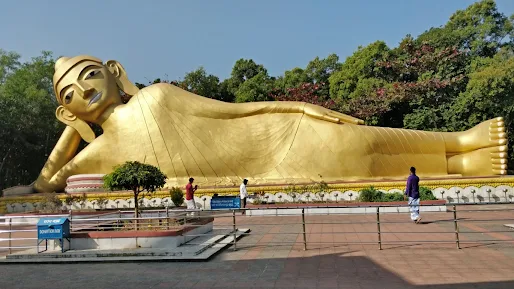Capturing the Sleeping Buddha: Photography Tips for Sandakphu Trekkers
The Sandakphu trek is a dream destination for adventure seekers and photography enthusiasts alike. Known for its panoramic views of the world’s highest peaks, including Mount Everest, Kanchenjunga, Lhotse, and Makalu, this trek offers an unparalleled opportunity to capture breathtaking landscapes. The highlight of the trek is the Sleeping Buddha, a majestic mountain formation resembling a reclining Buddha, making it a prime subject for photographers.
Whether you're a seasoned photographer or a beginner with a smartphone, capturing the essence of this mesmerizing trek requires planning, patience, and an eye for detail.
Understanding the Sleeping Buddha Formation
What is the Sleeping Buddha?
The Sleeping Buddha is a natural mountain formation created by a cluster of peaks, with Kanchenjunga forming the head and other peaks, including Kabru and Pandim, shaping the body. This formation is visible from various points along the Sandakphu trek and looks especially stunning during sunrise and sunset.
Best Time to Capture the Sleeping Buddha
The best seasons for photography are autumn (October-November) and spring (March-April). During these months, the skies are clear, and the golden light enhances the beauty of the mountains. Winter (December-February) also offers snow-covered landscapes, adding a magical touch to your photos.
Essential Photography Gear for the Sandakphu Trek
Camera Options
DSLR/Mirrorless Cameras – Ideal for high-resolution images and professional landscape photography.
Smartphones with Good Cameras – Modern smartphones with advanced night and zoom modes can capture excellent images.
Action Cameras – Useful for time-lapse videos and wide-angle shots.
Lenses for Trek Photography
Wide-angle lens (10-24mm or 16-35mm) – Perfect for capturing vast mountain landscapes.
Telephoto lens (70-200mm) – Useful for zooming in on distant peaks and wildlife.
Prime lens (50mm or 85mm) – Great for portraits and capturing intricate details of the trek.
Additional Gear
Tripod – Essential for night photography and long-exposure shots.
ND Filters – Helps in controlling light exposure, especially during bright daylight.
Extra Batteries & Memory Cards – Cold temperatures can drain batteries quickly, so carrying extras is crucial.
Lens Cleaning Kit – Dust and mist can affect image clarity.
Best Photo Spots Along the Sandakphu Trek
1. Manebhanjan – The Starting Point
This quaint village marks the beginning of the trek and offers a great opportunity to capture traditional Himalayan houses and local life. Early morning shots with mist-covered trails look especially enchanting.
2. Tumling – Sunrise and Cloudscapes
One of the most picturesque locations on the trek, Tumling provides panoramic views of the Sleeping Buddha, often framed by rolling clouds. A long exposure shot can beautifully capture the movement of mist over the valleys.
3. Kalipokhri – The Enchanted Lake
This high-altitude lake is an excellent spot for reflection photography. During sunrise and sunset, the calm waters mirror the golden hues of the sky, creating a surreal effect.
4. Sandakphu Summit – The Ultimate Panorama
At 3,636 meters, Sandakphu is the highest point of the trek and the best place to capture the entire Sleeping Buddha range. A panoramic shot at sunrise, with the peaks glowing in shades of orange and pink, is a must-have for any photographer.
5. Phalut – The Closest View of Kanchenjunga
For those extending their trek to Phalut, the rewards are immense. This spot offers the closest and clearest view of Kanchenjunga, making it perfect for detailed mountain photography.
Photography Techniques for Capturing the Sleeping Buddha
1. Golden Hour & Blue Hour Photography
Golden Hour (Sunrise & Sunset): The soft, warm light during these hours enhances the mountain textures.
Blue Hour (Dusk & Dawn): Captures the mystical, cold tones of the Himalayan landscape.
2. Composition Tips
Rule of Thirds: Position the Sleeping Buddha slightly off-center for a balanced composition.
Leading Lines: Use trekking trails, rivers, or clouds to guide the viewer’s eye toward the peaks.
Frame within a Frame: Utilize tree branches, prayer flags, or hut windows to add depth to your shots.
3. Long Exposure for Night Photography
The clear skies at Sandakphu make it a great location for astrophotography.
Use a tripod and set your camera to a long exposure (15-30 seconds) to capture star trails and the Milky Way.
4. Capturing Motion in the Landscape
Use a slow shutter speed (1/10s - 1s) to create dreamy cloudscapes.
A fast shutter speed (1/1000s or higher) is best for capturing moving trekkers and fluttering prayer flags.
People also like to read: The Enchanting Monasteries of Ladakh: A Spiritual Journey
Editing & Post-Processing Tips
1. Enhancing Colors & Contrast
Use Adobe Lightroom or Snapseed to adjust highlights, shadows, and contrast for a more dramatic effect.
2. Sharpening Details
Increase clarity for mountain textures.
Reduce noise for night shots to maintain image quality.
3. Removing Unwanted Elements
Use the healing brush tool to remove distractions like power lines or stray objects in the frame.
4. Creating Stunning Panorama Shots
Stitch multiple images together in Photoshop or Lightroom for a high-resolution panorama of the Sleeping Buddha.
Conclusion
Capturing the Sleeping Buddha during the Sandakphu trek is an unforgettable experience. Whether you're shooting wide-angle landscapes, detailed mountain textures, or stunning night skies, the key is to plan ahead, be patient, and experiment with different photography techniques. With the right gear, composition, and lighting, you can create breathtaking images that preserve the beauty of this Himalayan wonder forever.
So, pack your camera, lace up your trekking boots, and embark on a photographic journey to one of the most picturesque treks in India





Comments
Post a Comment